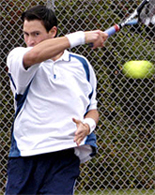Building the Spanish Forehand
Chris Lewit
Over the last 20 to 30 years, Spanish players have evolved from relatively defensive into athletic, physically dominant baseline players who also have all court capabilities.
Part of this evolution has been the technical development of more powerful, whipping, heavy-spin, but versatile forehands. These forehands have allowed Spanish players to continue to defend unbelievably well, but also attack with aggressiveness and force. Rafael Nadal's forehand - one of the best weapons in the modern game-- is the epitome of this trend.
Many coaches would kill to have their students hit a forehand like Rafa, but very few coaches have an understanding of what it takes develop such a weapon with a beginning player, or how to take a player who has learned a classical, "old school" forehand and rebuild it into a modern form.
Some coaches are only able to teach what they know: the classical way. Others may attempt to build a more modern swing, but get caught in the many pitfalls along the way.
Over the last few years, while researching a book project on Spanish tennis, I have been fortunate enough to travel annually to Spain to study with some of the best Spanish coaches, and to train and study at many of the best Spanish academies. My annual "pilgrimages," as I like to think of them, have shed much light onto the way Spanish coaches build big, Rafa-style forehands.
Using my studies in Spain a starting point, I have developed my own system for building the Spanish forehand. I have proven the system works with my high performance players at my school in New York-- as I think the video that goes with the article establishes. Now in this new series, I'm excited to share this system for the first time anywhere with Tennisplayer subscribers.
As in my previous series on the kick serve (Click Here), I will begin by detailing the technical reference points that I'm looking for when building a Spanish forehand. Then I'll move into a discussion of actual drills, exercises, variations, and developmental timelines, as well as what I believe are the common coaching pitfalls.




